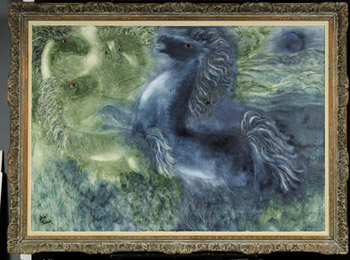Israeli art is on the ascendancy in the international marketplace, says a top-level Sotheby’s official.
“There has been a tremendous growth in appreciation of contemporary Israeli art in the last few years,” said Jennifer Roth, the auction house’s senior vice-president.
Roth, who organizes the annual Israel art and Judaica sales in New York and serves on the board of Sotheby’s Tel Aviv branch, will be in Toronto from June 19 to 21.
She will be here to find “hidden Israeli art treasures in Canadian collections” and, under the sponsorship of UJA Federation of Greater Toronto, will give a talk on the development of Israeli art from the founding of the Bezalel Academy in Jerusalem in 1906 to the present day.
“In recent years, Israeli art has exploded on the global scene,” said Roth, who was in Israel last week. “More and more young Israeli artists are appearing at biennials and curated exhibitions.”
She added, “At the same time, there is growing competition for classic Israeli art of earlier periods, from the 1920s to the 1979s, both from Israelis and international collectors. It’s not on the scale of Chinese art, but given Israel’s population, there is what I would call a mini boom in Israeli art.”
The boom began about a decade ago, she noted.
“Around this time, Israeli artists like Guy Ben Ner starting showing up in prestigious masters programs, and Bezalel launched its own masters program.”
As well, she said, more Israeli galleries opened and some started taking booths in international fairs.
At auctions today, the most popular Israeli works are by masters such as Reuven Rubin and Mordecai Ardon, whose paintings have fetched sums well over six figures.
“An Ardon was sold for more than $1 million to a Japanese museum, and Michal Rovner, a contemporary artist, sold an installation for over $800,000 just a few years ago.
Meanwhile, the photographer Adi Nes sold a work, based on Leonardo da Vinci’s The Last Supper, for more than $250,000.
Israeli art has passed through several thematic phases, she said.
“The early artists dealt with Zionism and the land and life in pre-and post-independent Israel. The ‘New Horizons’ group of the late 1940s and 1950s consisted of purely abstract painters who no longer felt obligated to deal with the Zionist narrative.”
By contrast, contemporary artists are extremely varied.
“Some are quite obviously political, and others less so. Many deal with the issues of war, security, borders.”
Israelis are particularly strong in photography and video art and tend to be highly experimental in the use of media and technology.
As for her search of Israeli art in Canadian attics, Roth said, “Some of our parents and grandparents travelled to Israel in the 1950s and 1960s and brought works by Rubin and Ardon from blue-chip dealers, not the sort of kitschy stuff one sees in tourist shops.”
For more information, e-mail [email protected]
